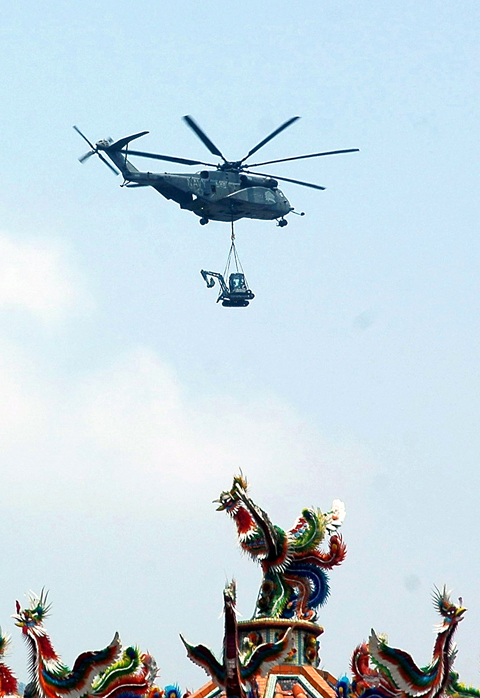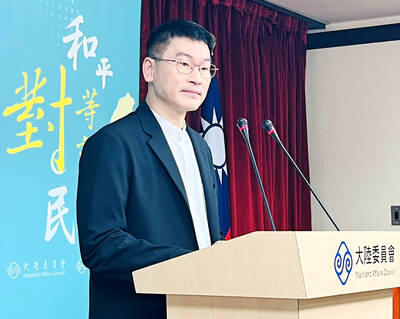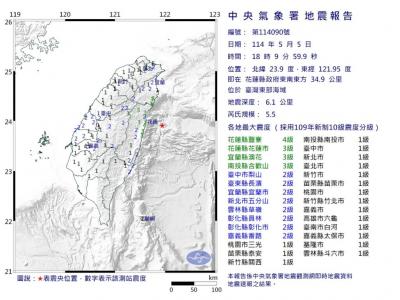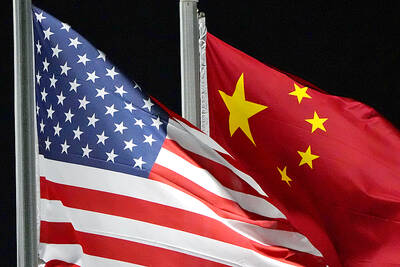The record-breaking rainfall brought by Typhoon Morakot was the main reason behind the floods and landslides that claimed hundreds of lives, but the natural disaster couldn*t mask the calamitous man-made errors wrought by the present government*s dysfunctional disaster prevention and rescue system, analysts said.
President Ma Ying-jeou*s (堜褙朐) role in rescue efforts came under the most scrutiny.
Ma failed to employ his constitutionally enshrined right to declare a state of emergency and he failed to order the mobilization of the armed forces to help stranded typhoon victims at the very beginning of the disaster, some analysts said.

PHOTO: CNA
They said these two decisions hobbled the much-〝criticized rescue process from the start.
Ma*s rationale that ※to proclaim emergency decrees was unnecessary as the 11 articles in the decree are incorporated into the Disaster Prevention and Protection Act [謈?衖洐跏]§ was ※unacceptable,§ said Chan Shou-chung (轙朄蘙), a former senior legislative aide involved in writing the Act in 2000.
※The issuance of an emergency decree has a dual meaning. Politically, it declares the government*s determination to make an all-out effort to rescue people as well as the president*s commitment to take charge of the relief work. Apparently Ma did not want this responsibility placed upon him,§ Chan said.
Furthermore, Chan said, not all of the principles of the emergency decrees are embodied in the Act.
※For example, the central government is entitled to deploy the military when an emergency decree is applied, but the Act stipulates that local governments may request support from the army in accordance with necessary procedures,§ he said.
Speaking of the difficulty a local government has in requesting military aerial support, Yang Chiu-hsing (暩灊?), commissioner of Kaohsiung County, where hundreds of people were buried by landslides, said that the National Rescue Command Center (NRCC) did not respond to his request positively until Aug. 10.
※[The NRCC] told me that they were waiting for a green light from their superiors, and it took two days,§ Yang said.
Data on the Web site of the Ministry of National Defense showed the number of soldiers sent to help typhoon victims in the six counties and cities did not reach more than 16,858 until Aug. 12, the fifth day after the disaster, up from 740 on the first day, 2,157 on the second, 5,358 on day three and 9,121 on the fourth day.
The NRCC is a standing agency of the National Fire Administration, under the Executive Yuan, responsible for aerial or marine rescues. Established after a tragedy in 2000 when four workers were washed away in Chiayi County*s Pachang Creek (齰翲祂) after their rescue was delayed by dithering officials, the NRCC is supposed to coordinate the deployment of the country*s rescue resources, but the disaster has called its effectiveness into question again.
※The case highlighted how inefficient and chaotic the rescue system is,§ Chan said.
Because Ma did not declare a state of emergency nor order the military to carry out rescue operations in his capacity as commander-in-chief, responsibility for the direct relief mission shifted onto the Central Emergency Operation Center (CEOC), an ad hoc facility.
The CEOC, led by Vice Premier Paul Chiu (珂櫆磡), who doubles as the chairman of the Executive Yuan*s National Disaster Prevention and Protection Commission, was activated on Aug. 6 after the sea warning for Typhoon Morakot was issued, with Minister of the Interior Liao Liou-yi (翍羛鴗) appointed commander.
On Aug. 9, Premier Liu Chao-shiuan (衒蟦?) decided to form a forward command post in Pingtung County, where thousands of people were stranded in inundated villages and Liao was relocated to command the new post.
With Liao in Pingtung, Minister without Portfolio Frank Fan (跜殌犕) became CEOC commander. However, he got into a quarrel with Tai Chiung-mei (赶枑崿), a Government Information Office (GIO) official, over handling the media. The CEOC received its third commander on Aug. 14, when Fan was replaced by Minister of Transportation and Communication Mao Chi-kuo (椈鶵玿).
※The rescue system has been in a state of anarchy as officials at the CEOC were not in a position to make major decisions in many aspects. Neither were they able to spur the armed forces into action. The biggest problem with the system was that officials who have the final word were not in charge,§ Chan said.
An official, who spoke on condition of anonymity, said that the squabble between Fan and Tai took place when Tai rejected Fan*s order to speak with the press, which she said was the duty of the GIO minister. This event showed the chaos of the rescue system, the official said.
※[Tai*s defiance] was understandable. With the higher-ups hidden from the frontline, how could you expect a civil servant to do a job beyond the scope of her position,§ he said.
Yang Yung-nane (暩蝯珒), a professor at the Department of Political Science at Cheng Kung University, said that the CEOC was bound to be uncoordinated as it was an ad hoc facility.
In accordance with the regulations established by the Executive Yuan*s National Disaster Prevention and Protection Commission, senior civil servants from different government departments take turns serving at the CEOC during the period of the center*s operation.
※As its members are from different departments of government, the CEOC is afflicted with selfish departmentalism. The golden time for rescuing survivors lapsed when the center was still floundering. Collecting, gathering and analyzing data or integrating rescue resources such as equipment, machines and manpower all fall under the jurisdiction of different departments,§ Yang said.
The government*s failure to reveal disaster information promptly and transparently was another problem.
It was not until Aug. 14, the seventh day after the disaster, that the CEOC began holding press conferences twice a day to update the public on the latest developments.
Before then, when facing reporters* inquiries regarding the disaster, Executive Yuan spokesman Su Jun-pin (憀鵙瑐) referred questions to the CEOC, where reporters were told to check the Web site, which provided very limited information making it unlikely people would have their questions answered by an official.
In an interview with CNN on Aug. 16, Ma said he would take full responsibility for the disaster, by which he meant looking into what went wrong with disaster prevention and rescue efforts and disciplining officials.
Shieh Jyh-cherng (祼礞嶀), a professor at the Department of Bio-〝Industrial Mechatronics Engineering at National Taiwan University and the secretary-general of the 921 Earthquake Relief Foundation, disagreed with Ma*s approach.
※There weren*t too many problems with the system per se that needed to be addressed. I don*t think it was problems with rules and regulations or the system that made the relief work weak and disorganized, but the human factor. The point was whether politicians could find it in their hearts to protect people,§ Shieh said.
For example, the regulations concerning emergency evacuation of people are clearly stipulated in the Disaster Prevention and Protection Act, but eventually it depends on the authority*s resolution to carry out a mandatory evacuation if it considers the move necessary because it might cause public complaints, he said.
※Even in a legal vacuum, to give a prompt response to help disaster victims is also possible. After the 921 Earthquake [that hit 〝Taiwan at 1:47am on Sept. 21, 1999], the Hengshan Military Command Center swung into action by 3am, the armed forces were already in quake-devastated areas by early morning, and the first foreign rescue teams from Japan arrived in the disaster areas that night, all this happened before former president Lee Teng-hui [軝崞?] declared a state of emergency, which occurred on Sept. 25,§ he said.

An essay competition jointly organized by a local writing society and a publisher affiliated with the Chinese Communist Party (CCP) might have contravened the Act Governing Relations Between the People of the Taiwan Area and the Mainland Area (臺灣地區與大陸地區人民關係條例), the Mainland Affairs Council (MAC) said on Thursday. “In this case, the partner organization is clearly an agency under the CCP’s Fujian Provincial Committee,” MAC Deputy Minister and spokesperson Liang Wen-chieh (梁文傑) said at a news briefing in Taipei. “It also involves bringing Taiwanese students to China with all-expenses-paid arrangements to attend award ceremonies and camps,” Liang said. Those two “characteristics” are typically sufficient

A magnitude 5.9 earthquake that struck about 33km off the coast of Hualien City was the "main shock" in a series of quakes in the area, with aftershocks expected over the next three days, the Central Weather Administration (CWA) said yesterday. Prior to the magnitude 5.9 quake shaking most of Taiwan at 6:53pm yesterday, six other earthquakes stronger than a magnitude of 4, starting with a magnitude 5.5 quake at 6:09pm, occurred in the area. CWA Seismological Center Director Wu Chien-fu (吳健富) confirmed that the quakes were all part of the same series and that the magnitude 5.5 temblor was

The Central Weather Administration has issued a heat alert for southeastern Taiwan, warning of temperatures as high as 36°C today, while alerting some coastal areas of strong winds later in the day. Kaohsiung’s Neimen District (內門) and Pingtung County’s Neipu Township (內埔) are under an orange heat alert, which warns of temperatures as high as 36°C for three consecutive days, the CWA said, citing southwest winds. The heat would also extend to Tainan’s Nansi (楠西) and Yujing (玉井) districts, as well as Pingtung’s Gaoshu (高樹), Yanpu (鹽埔) and Majia (瑪家) townships, it said, forecasting highs of up to 36°C in those areas

The brilliant blue waters, thick foliage and bucolic atmosphere on this seemingly idyllic archipelago deep in the Pacific Ocean belie the key role it now plays in a titanic geopolitical struggle. Palau is again on the front line as China, and the US and its allies prepare their forces in an intensifying contest for control over the Asia-Pacific region. The democratic nation of just 17,000 people hosts US-controlled airstrips and soon-to-be-completed radar installations that the US military describes as “critical” to monitoring vast swathes of water and airspace. It is also a key piece of the second island chain, a string of